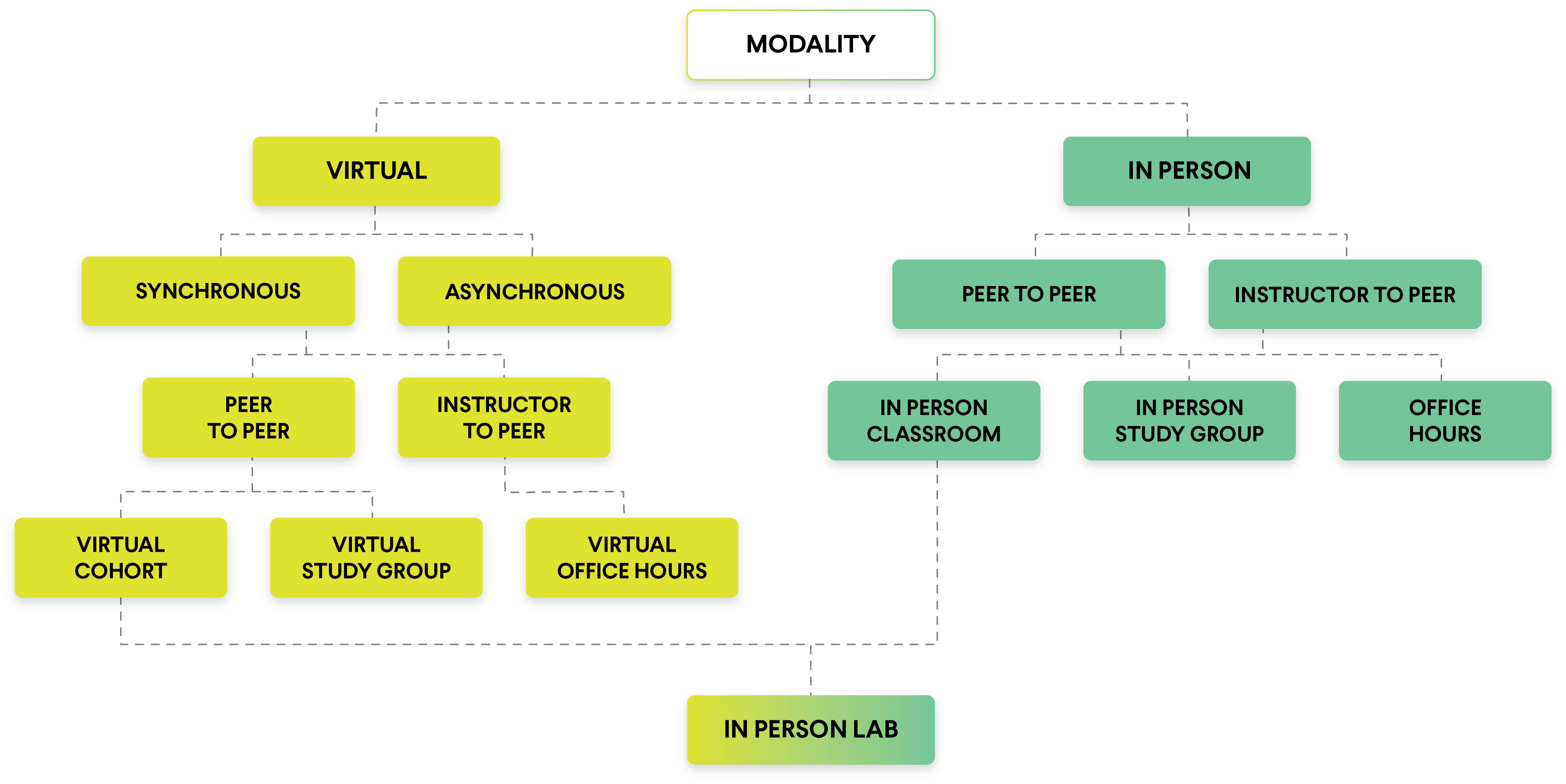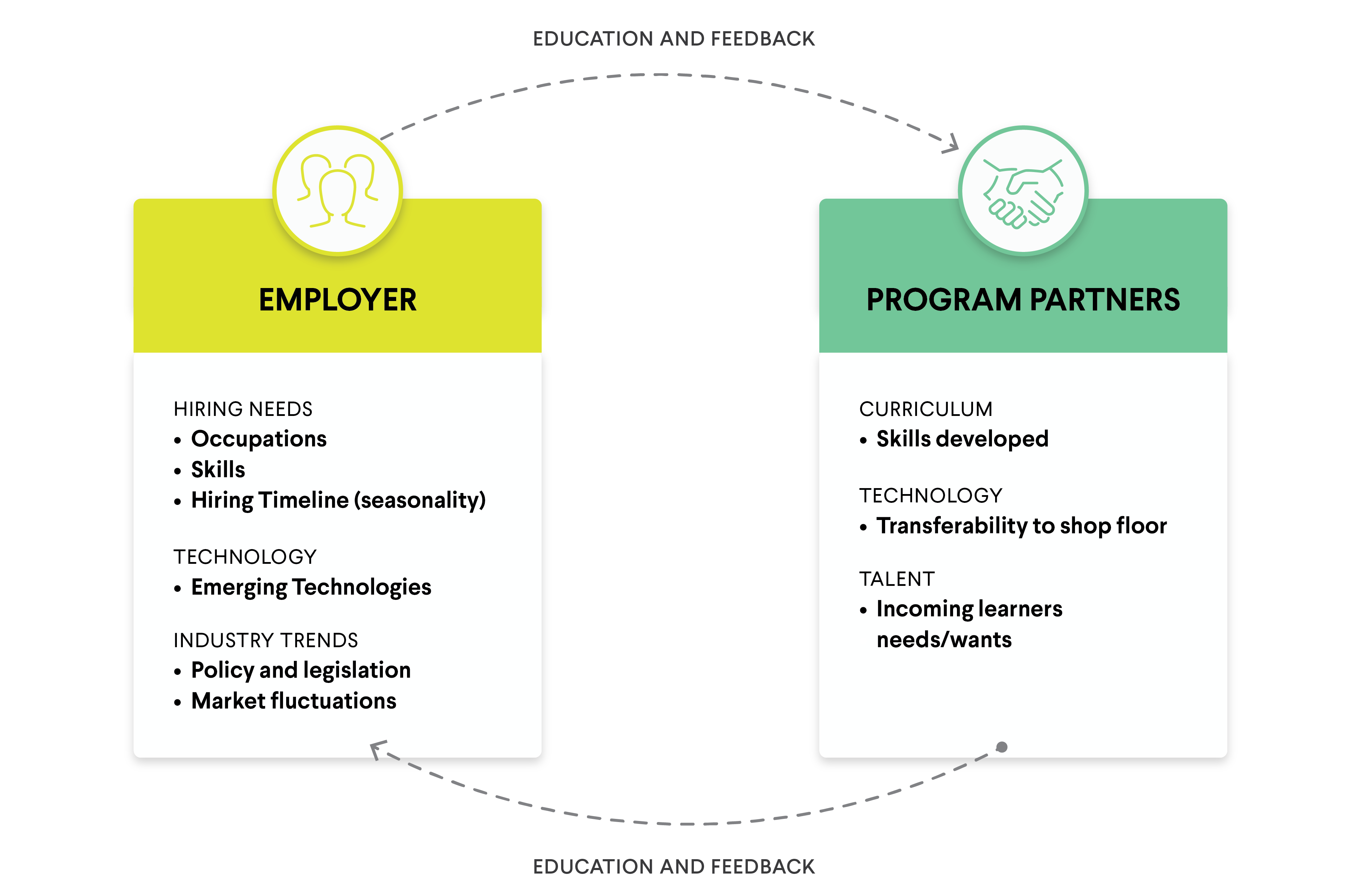Engaging With Your Surroundings
Field Guide for Workforce Technology Solutions
Connecting With Learners
Finding ways to meaningfully engage with learners is one of the most high-impact tactics shared by quality training providers. Over the course of the Future of Work Grand Challenge, our team observed a variety of strategies for learner engagement and the varying impacts and results each approach facilitates. Virtual and remote instruction can be a powerful tool because it improves access to education, but it can also limit learner engagement, which may negatively impact persistence and graduation rates.
When you’re thinking of offering a new training program, it’s important to consider the ways in which the program balances efficiency, accessibility, effectiveness, and engagement. In addition to assessing the training modality, you should consider the degree to which trainers interact one on one with learners and also how frequently learners interact with their peers throughout the program.
Taxonomy of Learner Engagement

MICRO CASE STUDY: In-Person Interactions in Virginia
The Hampton Roads Workforce Council and its Grand Challenge training provider teams initially offered entirely remote training programs but later began incorporating in-person collaboration time at American Job Center facilities with the goal of boosting learner persistence and engagement.
They found that bringing people together provided the human interaction and connection needed to keep learners on track. As part of the effort, The workforce council, which serves the Norfolk, Virginia, area, used funds from its capacity grant to hire a full-time program navigator to facilitate in-person services. The program navigator kept walk-in office hours, held employability skill boot camps for learners in one training program, and coordinated in-person study meetups for learners in another program. The navigator also connected learners across all training programs to supportive services that promote persistence and completion. The training provider, Dignity of Work, also doubled down on a more personal approach by hiring its own program navigator at the workforce council’s recommendation.

Tip
BUILD A PERSONAL CONNECTION
One thing we learned through the Future of Work Grand Challenge is that it’s a good idea to designate one individual as the primary point of contact for learners to reach out to when they have questions or need support. Having a single, consistent connection helps build familiarity and trust between learners and service providers. Later in the competition, we also found that sites that employed this strategy had higher response rates to follow-up surveys to determine job placement and retention rates.
Engaging With Employers
Workforce boards generally have their fingers on the pulse of growing industries and major employers in their regions. But when you explore emerging industry sectors, as you might when pursuing the ecosystem-building goal, it’s critical to involve employers in planning conversations as early as possible.
Understanding current hiring needs, including the types of jobs employers urgently need to fill and the skills that are in demand, helps shape training curricula, outreach materials, and job placement activities. It’s also important to make sure that employers are comfortable with any novel or nontraditional training technologies that your partners are planning to utilize. For example, if the training includes activities that take place in a virtual reality setting in place of in-person activities, it’s incumbent upon you and your partners to alleviate any concerns employers might have about the new approach by showing them that learners can build skills in a virtual setting just as effectively as they can in person.
Employment and Training Feedback Loop

Unusual Suspects — Engaging New Partners
Embarking on a project that requires your organization to step outside of its comfort zone gives you a unique opportunity to consider expanding your circle of partners beyond the usual suspects. The prospect of working with tech companies may seem intimidating or risky if your organization is just beginning to expand its tech portfolio. However, with some careful vetting and intentional exploration of the potential value a new partner could bring to your service offerings, the risk becomes much more calculated, and the payoff could be immense.
Adopting new technologies may mean venturing into new sectors that lie beyond the familiar education and workforce development ecosystem or literally expanding your geographic reach outside of your immediate service area. Pursuing new opportunities can help you reach new customer segments, develop innovative lines of service, access innovative solutions in new markets or ecosystems, gain insights from new partners who have unique perspectives on the existing landscape, and develop new sources of capital and investments in your organization and community.
Here are some questions to help guide you in considering additional technology providers that could lend valuable insights or resources to your efforts:
- Which organizations within your community are you not currently working with that could be viable partners for addressing a key problem you’ve identified? What about organizations outside of your community?
- Have you identified key gaps in capacity, skills, or knowledge that your organization is incapable of addressing? If so, which organizations, either locally, regionally, or nationally, could support your efforts to fill these needs?
- What new customers would you like to reach, and which organization(s) already serve them?
- What services and resources do those organizations provide that your organization does not or cannot? How would you envision working with those organizations and leveraging their services and resources to achieve your goals and better meet the needs of your customers?
- How could a particular partner complement existing service offerings in the education and workforce development ecosystems or connect your community to solutions in new and emerging ecosystems?
- What would success look like for a partnership with one of these organizations?
- Do these potential partners have the staff capacity to make your project a success?
Assessing Whether a Tech Partner Is the Right Fit for Your Community
Beyond understanding what assets a potential partner might provide to your organization and community, it’s also critical to make sure everyone involved shares the same values, especially when it comes to views on community engagement. A potential partner should recognize the importance of incorporating feedback from community members and other stakeholders into its program designs.
Here are a few questions to consider when assessing a potential partner’s values:
- Does this organization have experience working with a wide variety of stakeholders, including employers, learners, and other community-based organizations?
- Does the organization have a proven process for incorporating stakeholder feedback into its offerings?
- Is this organization making long-term investments in building and supporting local systems and infrastructure?
WHEN TO PROCURE AND WHEN TO PARTNER
Deciding when to procure goods or services from a provider rather than forging a partnership with another organization can be challenging, especially when you’re adopting new technology solutions. In some cases, you may need to do both because you are required to secure all service providers through a formal procurement process.
Here are a few questions to consider when assessing whether or not it makes sense to enter into a partnership with a provider:
- Is the provider’s primary goal to effectively meet the needs of my organization or the needs of the community my organization serves?
- Does the provider deliver a product that is meant to be customized to the unique needs of my community, or is it standardized?
- Does the provider express an interest in consistently meeting with us to review user experience feedback and outcomes data in order to improve effectiveness?
- Will our organization need to use this provider’s product or service on a long-term, ongoing basis, or will we just use it to meet a specific short-term need?
- Has the provider set aside resources to establish ongoing relationships with community stakeholders, which will be required for a successful partnership?




